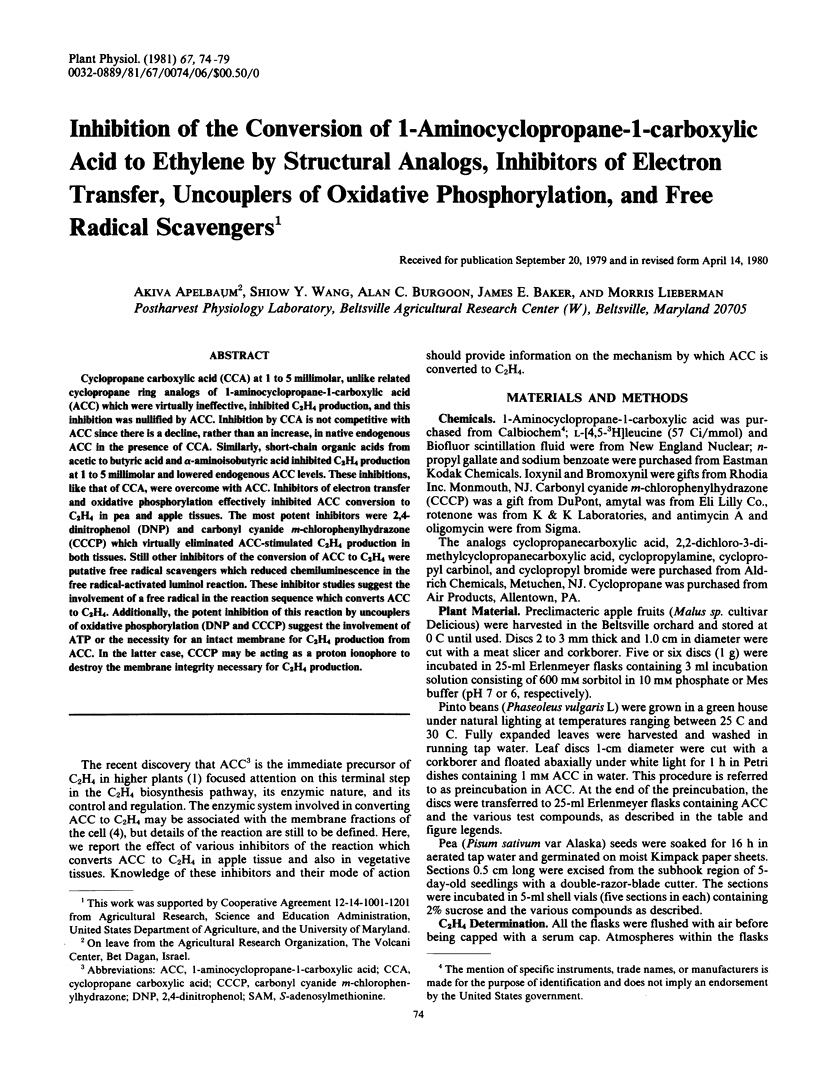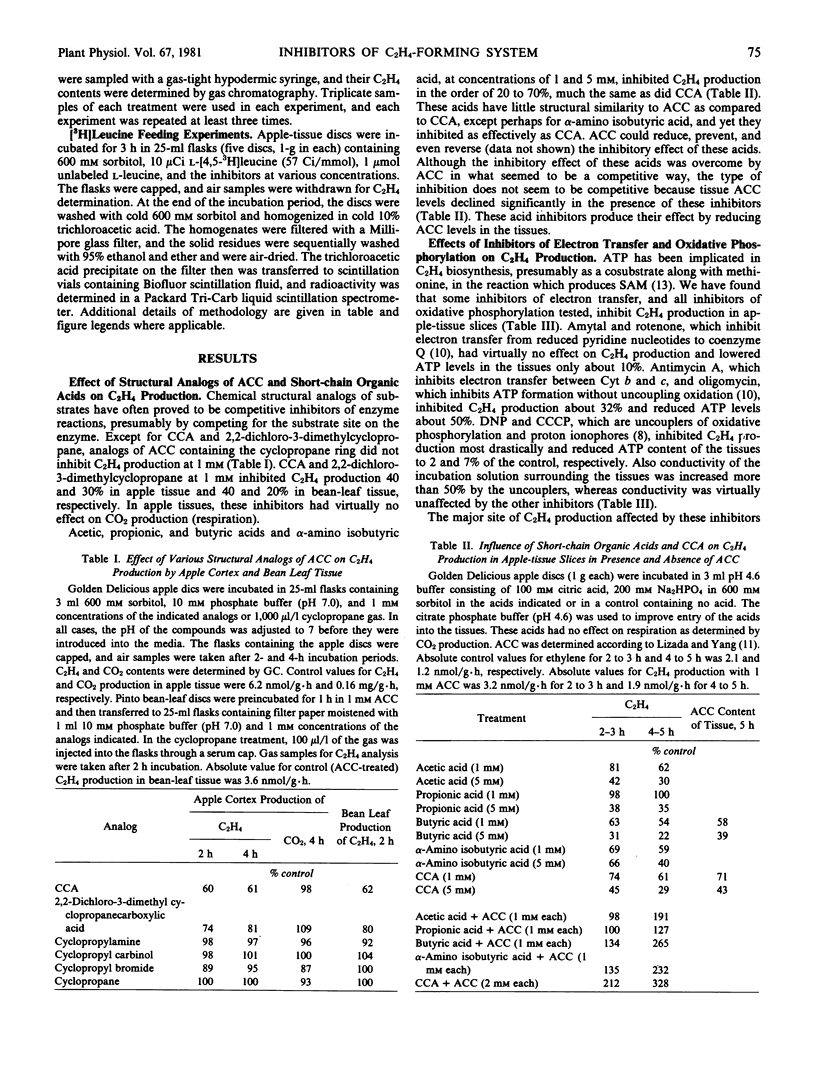Abstract
Cyclopropane carboxylic acid (CCA) at 1 to 5 millimolar, unlike related cyclopropane ring analogs of 1-aminocyclopropane-1-carboxylic acid (ACC) which were virtually ineffective, inhibited C2H4 production, and this inhibition was nullified by ACC. Inhibition by CCA is not competitive with ACC since there is a decline, rather than an increase, in native endogenous ACC in the presence of CCA. Similarly, short-chain organic acids from acetic to butyric acid and α-aminoisobutyric acid inhibited C2H4 production at 1 to 5 millimolar and lowered endogenous ACC levels. These inhibitions, like that of CCA, were overcome with ACC. Inhibitors of electron transfer and oxidative phosphorylation effectively inhibited ACC conversion to C2H4 in pea and apple tissues. The most potent inhibitors were 2,4-dinitrophenol (DNP) and carbonyl cyanide m-chlorophenylhydrazone (CCCP) which virtually eliminated ACC-stimulated C2H4 production in both tissues. Still other inhibitors of the conversion of ACC to C2H4 were putative free radical scavengers which reduced chemiluminescence in the free radical-activated luminol reaction. These inhibitor studies suggest the involvement of a free radical in the reaction sequence which converts ACC to C2H4. Additionally, the potent inhibition of this reaction by uncouplers of oxidative phosphorylation (DNP and CCCP) suggest the involvement of ATP or the necessity for an intact membrane for C2H4 production from ACC. In the latter case, CCCP may be acting as a proton ionophore to destroy the membrane integrity necessary for C2H4 production.
Full text
PDF





Selected References
These references are in PubMed. This may not be the complete list of references from this article.
- Adams D. O., Yang S. F. Ethylene biosynthesis: Identification of 1-aminocyclopropane-1-carboxylic acid as an intermediate in the conversion of methionine to ethylene. Proc Natl Acad Sci U S A. 1979 Jan;76(1):170–174. doi: 10.1073/pnas.76.1.170. [DOI] [PMC free article] [PubMed] [Google Scholar]
- Allen R. C., Loose L. D. Phagocytic activation of a luminol-dependent chemiluminescence in rabbit alveolar and peritoneal macrophages. Biochem Biophys Res Commun. 1976 Mar 8;69(1):245–252. doi: 10.1016/s0006-291x(76)80299-9. [DOI] [PubMed] [Google Scholar]
- Anderson J. D. Adenylate metabolism of embryonic axes from deteriorated soybean seeds. Plant Physiol. 1977 Apr;59(4):610–614. doi: 10.1104/pp.59.4.610. [DOI] [PMC free article] [PubMed] [Google Scholar]
- Apelbaum A., Burgoon A. C., Anderson J. D., Solomos T., Lieberman M. Some Characteristics of the System Converting 1-Aminocyclopropane-1-carboxylic Acid to Ethylene. Plant Physiol. 1981 Jan;67(1):80–84. doi: 10.1104/pp.67.1.80. [DOI] [PMC free article] [PubMed] [Google Scholar]
- Baker J. E., Lieberman M., Anderson J. D. Inhibition of ethylene production in fruit slices by a rhizobitoxine analog and free radical scavengers. Plant Physiol. 1978 Jun;61(6):886–888. doi: 10.1104/pp.61.6.886. [DOI] [PMC free article] [PubMed] [Google Scholar]
- Harold F. M. Conservation and transformation of energy by bacterial membranes. Bacteriol Rev. 1972 Jun;36(2):172–230. doi: 10.1128/br.36.2.172-230.1972. [DOI] [PMC free article] [PubMed] [Google Scholar]
- Lizada M. C., Yang S. F. A simple and sensitive assay for 1-aminocyclopropane-1-carboxylic acid. Anal Biochem. 1979 Nov 15;100(1):140–145. doi: 10.1016/0003-2697(79)90123-4. [DOI] [PubMed] [Google Scholar]
- Mattoo A. K., Lieberman M. Localization of the Ethylene-synthesizing System in Apple Tissue. Plant Physiol. 1977 Nov;60(5):794–799. doi: 10.1104/pp.60.5.794. [DOI] [PMC free article] [PubMed] [Google Scholar]
- Murr D. P., Yang S. F. Inhibition of in Vivo Conversion of Methionine to Ethylene by l-Canaline and 2,4-Dinitrophenol. Plant Physiol. 1975 Jan;55(1):79–82. doi: 10.1104/pp.55.1.79. [DOI] [PMC free article] [PubMed] [Google Scholar]


